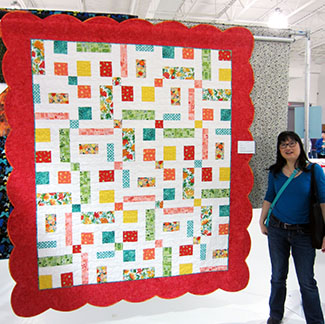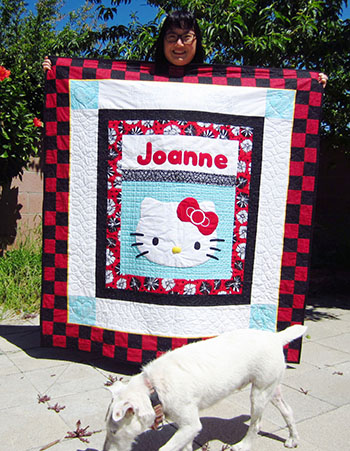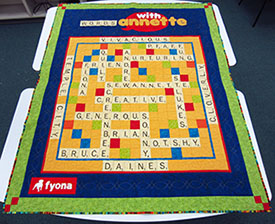
Tina Lai, MSW, LMSW, likes being able to provide individualized care. A medical social worker for Midland Care PACE (Program of All-inclusive Care for the Elderly) in Lawrence, Kansas, she is part of an eight-person team providing social services coordinated care.
Lai also enjoys quilting, a hobby that began somewhat by accident.
“It started in 1999 when I was an undergrad,” she said, when she noticed the person checking meal plan ID cards was always working on a “block,” one of the squares in handmade quilts. After talking with the woman about it, she purchased not just a one-block package but everything needed for a whole quilt.
“It was my way of avoiding writing my thesis,” she joked. “I thought, whoa! I didn’t know it was this much work! But I loved it. It was really fun. That year everything was hand-sewn. It’s the most basic form.”
Why Quilting?

Lai did 12 blocks but did not complete that first quilt, because “life got in the way.” She gave everything away for someone else to finish, and said it had been like “a draft project and it helped me learn the basics. It was like an internship.”
Lai made and completed her first quilt, a baby quilt, in 2001.
“It had blocks the shape of pinwheels,” she said. “By then I had a sewing machine. I had some tools, and in the early years, I made one quilt a year. It was a way to make something tangible that’s one of a kind for the people I love. It was a comfortable, creative outlet for me.”
Pictured at right: Tina Lai stands beside her "Bahama Mama" quilt at a 2016 show.
Lessons Learned
“There’s more math involved than people suspect, and you have to measure a lot,” she said. “A full-sized quilt probably takes three months for a working professional working on the quilt diligently.”
They have three layers but are flat so it’s easy to put together, Lai said. “I like it. It’s a tangible project, and you can see the progress being made and feel pride when you complete it.”
“With social work there are a lot of loose ends, and there’s no real end. There can be complications, that’s the reality of the job. I feel gratitude to quilts because they’re something you can complete.”
Lai said 2016 was “a banner year.” She was settling into her new place in Kansas and didn’t know anyone, but she made seven quilts.
“I thought quilting was a way to ground myself,” Lai said. “It was something familiar and something I can control. It’s a hobby, not a career.”
But she was touched a couple of times after she put a quilt in a box and gave it as a gift.
“They opened it and started crying,” Lai said. “One person said, ‘I’m going to be buried in this!’ It touched me so much. It was a way of saying ‘this is going to be with me forever.’”
Why Social Work?

After earning a bachelor’s degree and working in higher education administration program management for 20 years, a co-worker mentioned to Lai that she obviously loved people and enjoyed helping them—and that people naturally went to her for help.
Pictured: Lai with a quilt she made for someone obsessed with Hello Kitty. That's Lai's Jack Russell terrier, Schmeagle.
“I never saw myself as a counselor type, but I can relate to people,” Lai said. “I noticed social work and started talking to social workers.”
She realized that the profession offered “a huge variety of jobs” at both micro and macro levels, and she spent some time thinking about making a change to social work and wondering about pay differences. She also remembered a high school job working at the YMCA doing things that “fed my soul.”
Lai said Midland Care PACE, her current employer, provides home health services from several county-wide organizations for people 55 and older who qualify for home health and nursing care. Clients see specialists ranging from dietitians to social workers.
“People want to age in place,” she said. “We are able to individualize care, and we bring all the services to them so they don’t have to go to a nursing home. It’s like United Way’s national concept with all independent nonprofits.”
Similarities Between Social Work and Quilting

Lai said her profession and her hobby have both taught her to let go. When considering the career change to social work, she thought about the joy she saw when she gave a quilt to someone and the varied job possibilities in social work. Despite the pay discrepancy, Lai said she ultimately decided there are “things in life that are not really about money.”
After she became a social worker, she remembered a time when a person to whom she had given one of her quilts gave it away to someone else. “I was so offended,” Lai said. “But I thought, ‘It is theirs; you’ve got to let it go.’ As a social worker, you want people to make the right choices … sometimes more than is healthy for us. I think that’s the primary lesson—to just let go after you give the quilt or provide the service.”
Pictured: "Words with Friends," anyone? Tina Lai's friend, Annette, was obsessed with this online game. So Lai created her own board game with words describing her and her family.
What’s Next?
“I feel settled now and am growing in this place,” Lai said. “I’m in the same city as the University of Kansas and was asked to be a lecturer, so I’m mulling the idea to teach social work at the university.”
You can see more of her quilts on Tina's personal website.